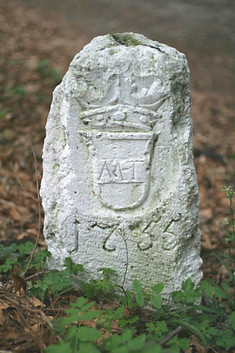History
The “Ofenbacher Forst” (today popularly known as the “Kaiserwald”, see also Austrian map sheet l06; Aspang Markt) was transferred to state ownership by Empress Maria Theresa in 1755. Numerous large boundary stones (M.T. 1755) still bear witness to this in nature today. Organizationally, Ofenbach was assigned to the Vienna Forest Inspection District of the State Domain Administration.
It was not until 1925, with the establishment of the Austrian Federal Forests, that the Wr. Neustadt Forest Administration was created, to which the forests of the Wr. Neustadt Religious Fund Estate were then also assigned. Until 1972, the Ofenbach forest (former domain forests and religious fund forests) was divided into two forester service districts (Ofenbach, Heuberg).
Although not large, the Kaiserwald was evidently always of great interest for forestry in this area. A “forestry sketch” from 1866 describes the Kaiserwald as follows:
“It is that dense forest complex, uninterrupted by any settlements in its interior, not very extensive in itself, but excellently preserved, which extends on the right bank of the Schwarzau over the highest mountain ridge of the Austro-Hungarian border mountains and is generally called the Offenbach Forest. The value and significance of this isolated forest in state ownership as a traditional appendix to the Vienna Woods deserves all the more attention, as it also appears to be called upon to express the character of conservative endeavor in the best sense of a forestry activity not misguided by profit-seeking goals under conditions where the forest's sources of yield are exploited without further consideration until they are exhausted.”
The Rosalienstrasse (Forchtenstein Castle - Fernblick) was built in 1936 and the Rosalien and Heuberghäuser were electrified in 1953.
According to tradition, the location on the border with Hungary caused the smuggling trade to flourish. Numerous place names, which are increasingly being forgotten, bear witness to this - e.g. “Hendelkramer-Stein” on “Weiße Kreuzstraße”, “Ochsentritt” in section 5 b “Saustandbrücke” - section 16/17 on Heubergstraße.
The area was developed for tourism early on (1920/1930).
Two markings (blue/white and yellow/white) were laid out by the tourist associations. A popular excursion from Vienna was e.g: Vienna - Aspangbahn - Klein Wolkersdorf - Rosalia - Mattersburg - Vienna.
An interesting introduction to the history of the area can be found in the local history book of the market town of Lanzenkirchen, the 2nd edition of which was published in 1985.
-

A boundary stone from the year 1755
